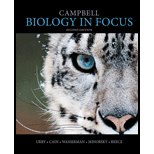
Campbell Biology in Focus (2nd Edition)
2nd Edition
ISBN: 9780321962751
Author: Lisa A. Urry, Michael L. Cain, Steven A. Wasserman, Peter V. Minorsky, Jane B. Reece
Publisher: PEARSON
expand_more
expand_more
format_list_bulleted
Concept explainers
Textbook Question
Chapter 3.4, Problem 1CC
Compare the structure of a fat (triglyceride) with that of a phospholipid.
Expert Solution & Answer
Want to see the full answer?
Check out a sample textbook solution
Students have asked these similar questions
What is the structure and function of Eukaryotic cells, including their organelles? How are Eukaryotic cells different than Prokaryotic cells, in terms of evolution which form of the cell might have came first? How do Eukaryotic cells become malignant (cancerous)?
What are the roles of DNA and proteins inside of the cell? What are the building blocks or molecular components of the DNA and proteins? How are proteins produced within the cell? What connection is there between DNA, proteins, and the cell cycle? What is the relationship between DNA, proteins, and Cancer?
Why cells go through various types of cell division and how eukaryotic cells control cell growth through the cell cycle control system?
Chapter 3 Solutions
Campbell Biology in Focus (2nd Edition)
Ch. 3.1 - How are gasoline and fat chemically similar?Ch. 3.1 - Which molecules in Figure 3.4a re isomers? For...Ch. 3.1 - Prob. 3CCCh. 3.1 - Prob. 4CCCh. 3.2 - How many molecules of water are needed to...Ch. 3.2 - WHAT IF? Suppose you eat a serving of fish. What...Ch. 3.3 - Write the formula for a monosaccharide that has...Ch. 3.3 - A dehydration reaction joins two glucose molecules...Ch. 3.3 - WHAT IF? After a cow is given antibiotics to treat...Ch. 3.4 - Compare the structure of a fat (triglyceride) with...
Ch. 3.4 - Why are human sex hormones considered lipids?Ch. 3.4 - Prob. 3CCCh. 3.5 - Why does a denatured protein no longer function...Ch. 3.5 - What parts of a polypeptide participate in the...Ch. 3.5 - WHAT IF? Where would you expect a polypeptide...Ch. 3.6 - DRAW IT Go to Figure 3.27a and, for the top three...Ch. 3.6 - Prob. 2CCCh. 3.7 - How would sequencing the entire genome of an...Ch. 3.7 - Given the function of DNA, why would you expect...Ch. 3 - Prob. 1TYUCh. 3 - Which functional group is not present in this...Ch. 3 - MAKE CONNECTIONS Which chemical group is most...Ch. 3 - Prob. 4TYUCh. 3 - Which of the following statements concerning...Ch. 3 - The structural level of a protein least a fleeted...Ch. 3 - Enzymes that break down DNA catalyze the...Ch. 3 - Prob. 8TYUCh. 3 - The molecular formula for glucose is C6H12O6. What...Ch. 3 - Construct a table that organizes the following...Ch. 3 - Prob. 11TYUCh. 3 - Prob. 12TYUCh. 3 - FOCUS ON ORGANIZATION Proteins, which have diverse...Ch. 3 - Prob. 14TYUCh. 3 - SYNTHESIZE YOUR KNOWLEDGE Given that the function...
Additional Science Textbook Solutions
Find more solutions based on key concepts
An obese 55-year-old woman consults her physician about minor chest pains during exercise. Explain the physicia...
Biology: Life on Earth with Physiology (11th Edition)
Calculate the lattice energy of CaCl2 using a Born-Haber cycle and data from Appendices F and L and Table 7.5. ...
Chemistry & Chemical Reactivity
Why do scientists think that all forms of life on earth have a common origin?
Genetics: From Genes to Genomes
Gregor Mendel never saw a gene, yet he concluded that some inherited factors were responsible for the patterns ...
Campbell Essential Biology (7th Edition)
Knowledge Booster
Learn more about
Need a deep-dive on the concept behind this application? Look no further. Learn more about this topic, biology and related others by exploring similar questions and additional content below.Similar questions
- In one paragraph show how atoms and they're structure are related to the structure of dna and proteins. Talk about what atoms are. what they're made of, why chemical bonding is important to DNA?arrow_forwardWhat are the structure and properties of atoms and chemical bonds (especially how they relate to DNA and proteins).arrow_forwardThe Sentinel Cell: Nature’s Answer to Cancer?arrow_forward
- Molecular Biology Question You are working to characterize a novel protein in mice. Analysis shows that high levels of the primary transcript that codes for this protein are found in tissue from the brain, muscle, liver, and pancreas. However, an antibody that recognizes the C-terminal portion of the protein indicates that the protein is present in brain, muscle, and liver, but not in the pancreas. What is the most likely explanation for this result?arrow_forwardMolecular Biology Explain/discuss how “slow stop” and “quick/fast stop” mutants wereused to identify different protein involved in DNA replication in E. coli.arrow_forwardMolecular Biology Question A gene that codes for a protein was removed from a eukaryotic cell and inserted into a prokaryotic cell. Although the gene was successfully transcribed and translated, it produced a different protein than it produced in the eukaryotic cell. What is the most likely explanation?arrow_forward
- Molecular Biology LIST three characteristics of origins of replicationarrow_forwardMolecular Biology Question Please help. Thank you For E coli DNA polymerase III, give the structure and function of the b-clamp sub-complex. Describe how the structure of this sub-complex is important for it’s function.arrow_forwardMolecular Biology LIST three characteristics of DNA Polymerasesarrow_forward
arrow_back_ios
SEE MORE QUESTIONS
arrow_forward_ios
Recommended textbooks for you
 Biology Today and Tomorrow without Physiology (Mi...BiologyISBN:9781305117396Author:Cecie Starr, Christine Evers, Lisa StarrPublisher:Cengage Learning
Biology Today and Tomorrow without Physiology (Mi...BiologyISBN:9781305117396Author:Cecie Starr, Christine Evers, Lisa StarrPublisher:Cengage Learning Concepts of BiologyBiologyISBN:9781938168116Author:Samantha Fowler, Rebecca Roush, James WisePublisher:OpenStax College
Concepts of BiologyBiologyISBN:9781938168116Author:Samantha Fowler, Rebecca Roush, James WisePublisher:OpenStax College

Biology Today and Tomorrow without Physiology (Mi...
Biology
ISBN:9781305117396
Author:Cecie Starr, Christine Evers, Lisa Starr
Publisher:Cengage Learning




Concepts of Biology
Biology
ISBN:9781938168116
Author:Samantha Fowler, Rebecca Roush, James Wise
Publisher:OpenStax College

Macromolecules | Classes and Functions; Author: 2 Minute Classroom;https://www.youtube.com/watch?v=V5hhrDFo8Vk;License: Standard youtube license